

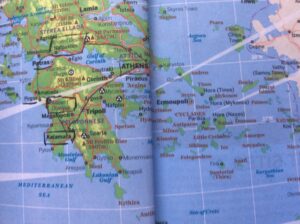 Greece, Greece, we must go to Greece, says B. He’s 91. I get tickets.
Greece, Greece, we must go to Greece, says B. He’s 91. I get tickets.
Why am we so smitten by Greece? From the first time I saw Athens, coming in by bus and glimpsing the Parthenon floating on the Acropolis I have loved the place.
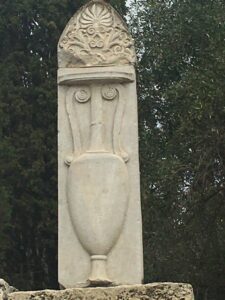
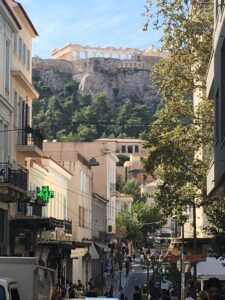 Forget the slavery, men’s views on women, their bellicosity and infighting, that touchy Achilles, their religion which has nothing of transcendence or universal love, and think of the Greek love of beauty – the sight of a beautiful naked body! (why did this vanish with Christianity?) – their curiosity and friendliness, their openness to every idea. Their love of life. The blue and white of the place itself, the sea, sky and the mountains, the crystalline clarity of the air.
Forget the slavery, men’s views on women, their bellicosity and infighting, that touchy Achilles, their religion which has nothing of transcendence or universal love, and think of the Greek love of beauty – the sight of a beautiful naked body! (why did this vanish with Christianity?) – their curiosity and friendliness, their openness to every idea. Their love of life. The blue and white of the place itself, the sea, sky and the mountains, the crystalline clarity of the air.
B and I travelled everywhere by bus, from Athens to Delphi, then weaving along the coast to Nafpaktos, then over the new bridge spanning the Gulf of Corinth. Patras, then down to Pyrgos and Olympia, then down to Kalamata on the Aegean, and back by Express to Athens, on a motorway where we dived into tunnels and emerged to soar over the mountains of the Peloponnese. We seemed to fly and never stopped.
ATHENS
Fly to Athens with Wizz Air, Hungarian airline – cheap so we are 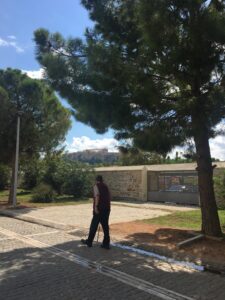 squashed, and B whacked at the end. Take the metro overland through low scrubby hills then underground into central Athens, change at Syntagma, and one stop to Thissio, where we emerge to familiar lions heads along the station parapet, and sink into chairs under the awning of Gyristroula, our restaurant run by welcoming old boys. There’s the ancient Agora and the Haephestion. We’re back. Jason Hotel is only a stone’s throw, where from our balcony I can see the Observatory and the Hill of the Pynx, the ancient necropolis and even by leaning the Acropolis.
squashed, and B whacked at the end. Take the metro overland through low scrubby hills then underground into central Athens, change at Syntagma, and one stop to Thissio, where we emerge to familiar lions heads along the station parapet, and sink into chairs under the awning of Gyristroula, our restaurant run by welcoming old boys. There’s the ancient Agora and the Haephestion. We’re back. Jason Hotel is only a stone’s throw, where from our balcony I can see the Observatory and the Hill of the Pynx, the ancient necropolis and even by leaning the Acropolis.
Rooftop breakfast, gazing at the Parthenon. All municipal buses are on strike, so B sits back while I walk down Ermou to Syntagma Square, and on a whim get on tourist bus which whirls me past the National Library, Ormonia Square and more. Most buildings are grubby, daubed with tired graffiti. The bus disgorges me below the Parthenon, on a track which leads round the Acropolis to our area, Thissio. Green & ok.
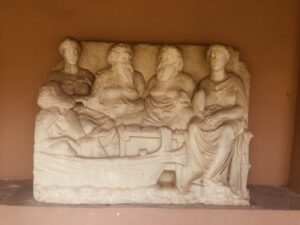 Next day B is feeling fit, and we walk past the Synagogue and under trees through the Holocaust Memorial Garden with stone boulders shaped like a broken Star of David. A track to the necropolis entrance. We wander down. Like all ancient
Next day B is feeling fit, and we walk past the Synagogue and under trees through the Holocaust Memorial Garden with stone boulders shaped like a broken Star of David. A track to the necropolis entrance. We wander down. Like all ancient 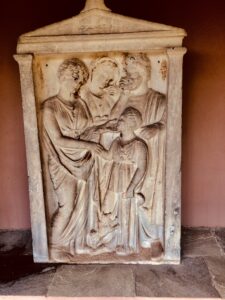 sites, it’s at a lower level than today’s buildings. Amazing the way land builds up over the centuries – dust, rubbish, dead vegetation? Amusing plaque of two old boys gassing with bored wives either side, funeral meats set on a table, and Charon fed up in his boat waiting to row them over the Styx. Rough but a gem. Another of a girl – mother chucks her under the chin, father wipes away a tear, and her little dog jumps up – don’t leave, don’t leave! Love the intimacy of family life so long ago – the girl even has a name – such a contrast to formal bombastic statues – (I never wrote it down). Tall elegant urns.
sites, it’s at a lower level than today’s buildings. Amazing the way land builds up over the centuries – dust, rubbish, dead vegetation? Amusing plaque of two old boys gassing with bored wives either side, funeral meats set on a table, and Charon fed up in his boat waiting to row them over the Styx. Rough but a gem. Another of a girl – mother chucks her under the chin, father wipes away a tear, and her little dog jumps up – don’t leave, don’t leave! Love the intimacy of family life so long ago – the girl even has a name – such a contrast to formal bombastic statues – (I never wrote it down). Tall elegant urns.
Ouzo at the Tarzan with painted black walls.
Next day taxi to bus station, and bus through the warehouses and factories of outer Athens to hills blackened by forest fires. Eventually reach
DELPHI and THE CAVE
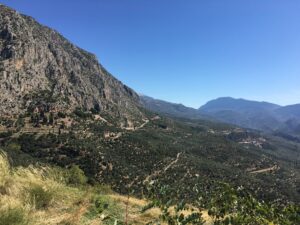
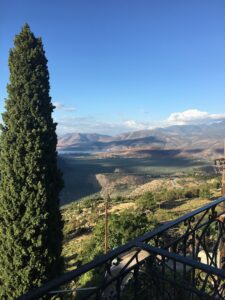 on the slopes slope of Mount Parnassus, home of the Muses. No forest fires here, just green trees, dwarf oaks and pines. Been twice before, so again to the Hotel Hermes, our room looking down to the dazzling Gulf of Corinth, where triremes anchored in the ancient port of Kirra. Pilgrims staggered up the track to ask the Pythia at Apollo’s temple their questions for the future. I saw and
on the slopes slope of Mount Parnassus, home of the Muses. No forest fires here, just green trees, dwarf oaks and pines. Been twice before, so again to the Hotel Hermes, our room looking down to the dazzling Gulf of Corinth, where triremes anchored in the ancient port of Kirra. Pilgrims staggered up the track to ask the Pythia at Apollo’s temple their questions for the future. I saw and 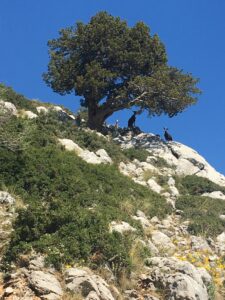 felt it all. Silence is palpable, profound. The gods are still here. They wait.
felt it all. Silence is palpable, profound. The gods are still here. They wait.
This time I wanted to climb to the Corycian Cave, a place of 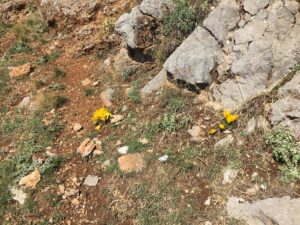 worship older and higher than the site of Delphi. But, nine km! I knew I wasn’t up to it, there and back, and so eventually for 70 euros a taxi took me to the far side of the mountain. We drove twistingly through a winter ski resort. The driver stopped at the start of a track. Just go along, he said, turn right at a fork then carry on up. So I did, after one false turn. It was a steady tramp, without views because pines blocked the way. Up and up. Then, a turning point for four wheel drives, and a rough sign pointing to a little path, ‘Corycian Cave.’ Music! I hear the muses calling me. Belled black and white
worship older and higher than the site of Delphi. But, nine km! I knew I wasn’t up to it, there and back, and so eventually for 70 euros a taxi took me to the far side of the mountain. We drove twistingly through a winter ski resort. The driver stopped at the start of a track. Just go along, he said, turn right at a fork then carry on up. So I did, after one false turn. It was a steady tramp, without views because pines blocked the way. Up and up. Then, a turning point for four wheel drives, and a rough sign pointing to a little path, ‘Corycian Cave.’ Music! I hear the muses calling me. Belled black and white 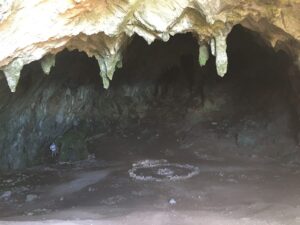 goats caper above. Gold crocuses bloom. And there is the cave, rimmed with massive stalactites like teeth of a fossilised monster.
goats caper above. Gold crocuses bloom. And there is the cave, rimmed with massive stalactites like teeth of a fossilised monster.
Slowly I see through the dark. To the left is a natural rock altar, about six feet high, green with 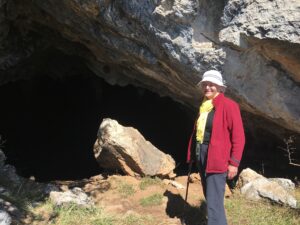 algae. It is the head of a goddess, with eyes and mouth. Ancient. Before her lies a circular hearth rimmed with stones where a fire has burned. The sacred flame. Flowers and beads had been laid by recent pilgrims on her eyes and mouth and head. I know archaeologists found here female figurines their arms raised in blessing, now on show in the museum far below, but this sanctuary is still alive, its worship and rites continuing through millennia.
algae. It is the head of a goddess, with eyes and mouth. Ancient. Before her lies a circular hearth rimmed with stones where a fire has burned. The sacred flame. Flowers and beads had been laid by recent pilgrims on her eyes and mouth and head. I know archaeologists found here female figurines their arms raised in blessing, now on show in the museum far below, but this sanctuary is still alive, its worship and rites continuing through millennia.
Only in later times was Apollo’s temple far below erected, with its priestess the Pythia sitting on a tripod and mumbling her prophecies, and the stadium, the treasuries, and the winged Naxos sphinx on the top of a column, wrapped by the mountains and silence.
I am not alone in the cave, in the back are two Australians, exploring, thrilled. We walked back down the track to their car, and they give me a lift to Delphi village.
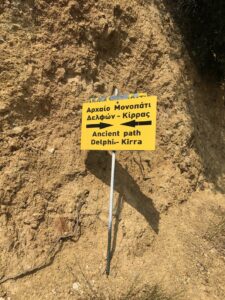 A day or two later I walked down the original path to Kirra, pebbly and steep in places, worn by pilgrims. I never made it all the way down to the port, only to a modern canal skirting the mountain side. Prickly dwarf oaks, evergreen (I gathered acorns – now in a
A day or two later I walked down the original path to Kirra, pebbly and steep in places, worn by pilgrims. I never made it all the way down to the port, only to a modern canal skirting the mountain side. Prickly dwarf oaks, evergreen (I gathered acorns – now in a 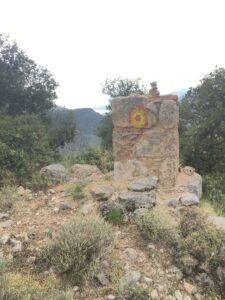 seed tray in the greenhouse). Autumn flowers, and painted wayside rocks, and an Orthodox shrine devoted to, as always, the Virgin. I wonder again, how did the Greeks change from their
seed tray in the greenhouse). Autumn flowers, and painted wayside rocks, and an Orthodox shrine devoted to, as always, the Virgin. I wonder again, how did the Greeks change from their 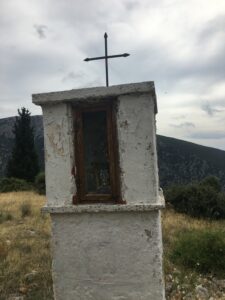 rationalism, their love of naked beauty, their sheer common sense, their tolerance and
rationalism, their love of naked beauty, their sheer common sense, their tolerance and 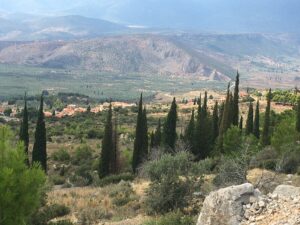 feeling of enquiry, respectful worship of their humanoid gods to the mystic passion of Orthodox Christianity? Ahead lies the blue Gulf, and the mountains, punctuated by the dark vertical cypresses.
feeling of enquiry, respectful worship of their humanoid gods to the mystic passion of Orthodox Christianity? Ahead lies the blue Gulf, and the mountains, punctuated by the dark vertical cypresses.
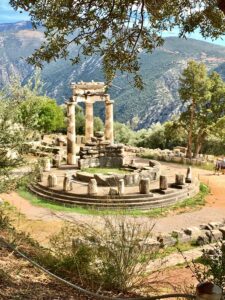 Another afternoon to the tholos, the remains of a circular temple to Athena (only three columns, but stunning, wrapped by the mountains and silence. On the outskirts of Delphi.
Another afternoon to the tholos, the remains of a circular temple to Athena (only three columns, but stunning, wrapped by the mountains and silence. On the outskirts of Delphi.
And a day with Bob in a taxi to Hosios Lukas, the Monastery of St Luke – medieval Greek saint. Like Ravenna, the gold mosaics glitter gold, each 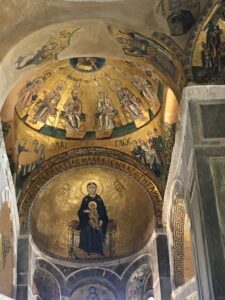
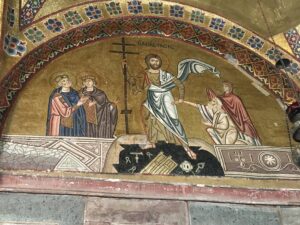
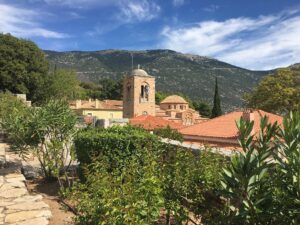
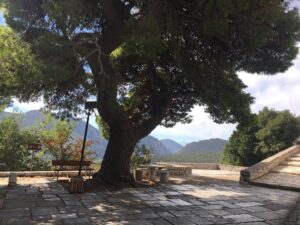 facet quivering with life. Enter the church and faced by the Virgin and child seated in their sea of gold eternity. Christ baptized in a squinch, Christ hauling a clothed Adam and Eve from the grave of hell, Christ in his solemn glory. A
facet quivering with life. Enter the church and faced by the Virgin and child seated in their sea of gold eternity. Christ baptized in a squinch, Christ hauling a clothed Adam and Eve from the grave of hell, Christ in his solemn glory. A 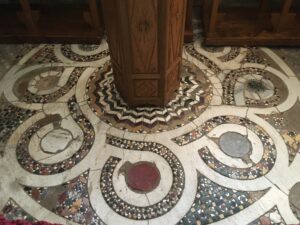 cosmati circle around a pillar (I think they are linked planets and stars). Courtyard overlooking miles of olives, trees, mountains. Again, this glorious silence.
cosmati circle around a pillar (I think they are linked planets and stars). Courtyard overlooking miles of olives, trees, mountains. Again, this glorious silence.
Amenable taxi driver takes us through the village of Distormo, with memorial (apparently built by the Germans in reparation) to men shot by the Germans. Then, since Bill has supplied us with details, he uses his satnav to drive to the meeting point of Oedipus and Laius, where Oedipus, coming from Delphi, kills his father. The first recorded road rage! It’s a fork, a path going off from here through the mountains. There’s a modern memorial but its inscription in ancient Greek which even the driver cannot read. The 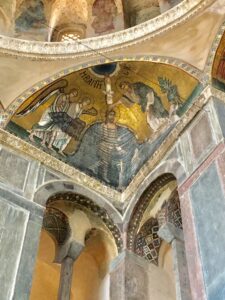 driver is laughing, to think of all the times I’ve come along this road, he says, and I’ve never seen this! I photograph it, send it to Geordie, who in due course shows it to his classics teacher, who says it is Sophocles description of the event, and even
driver is laughing, to think of all the times I’ve come along this road, he says, and I’ve never seen this! I photograph it, send it to Geordie, who in due course shows it to his classics teacher, who says it is Sophocles description of the event, and even 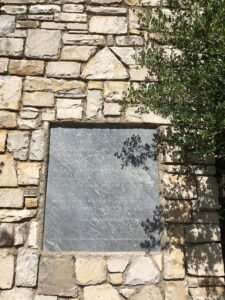 supplies the text in English.
supplies the text in English.
Buses come from Athens to Delphi, but not many westwards beyond. Time tables are erratic, and at the café/bus centre the owner has to ring to find the next bus going west, not back to Athens. There’s one tomorrow at 5.30 pm to Nafpaktos, a town on the gulf, really nice says the young man manning the Hermes reception.
So, packed up we lounge around all day, reading at the Hermes, coffee here, light lunch here, another coffee there, while I do some trotting around the little village, see a mural of olive pickets and chat incomprehensible nothings with a 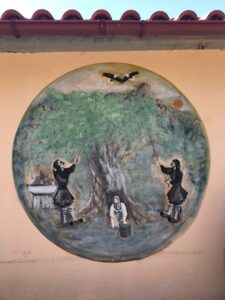 man waving from a window. The bus comes, and for three hours we weave round the gulf coast backed by mountains, in and out of villages, retracing our steps, with water lapping us on one side. It’s like Scotland, driving to Tarbert. It’s dark when we get to Nafpaktos, where we are now the only passengers. Without asking, the driver phones for a taxi, tells us to stay where we are, and drives off. Taxi comes, takes us to the Hotel Akti which I booked yesterday, using The Lonely Planet. Uptight receptionist (strange for Greece, owner smiles as though apologetically) but all is well, supper across the road and large room, with in the morning a sea view.
man waving from a window. The bus comes, and for three hours we weave round the gulf coast backed by mountains, in and out of villages, retracing our steps, with water lapping us on one side. It’s like Scotland, driving to Tarbert. It’s dark when we get to Nafpaktos, where we are now the only passengers. Without asking, the driver phones for a taxi, tells us to stay where we are, and drives off. Taxi comes, takes us to the Hotel Akti which I booked yesterday, using The Lonely Planet. Uptight receptionist (strange for Greece, owner smiles as though apologetically) but all is well, supper across the road and large room, with in the morning a sea view.
NAFPAKTOS
A day for Bob to recover on our sheltered balcony, while I explore, also 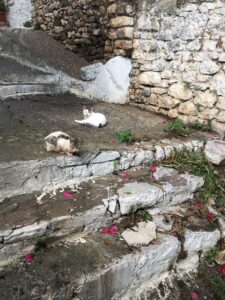 try to find the bus stop for tomorrow. Pretty old town backed by hill with layers of battlemented fortress – Venetian then Ottoman you name it as they fought and took over one after the other but I can’t tell
try to find the bus stop for tomorrow. Pretty old town backed by hill with layers of battlemented fortress – Venetian then Ottoman you name it as they fought and took over one after the other but I can’t tell 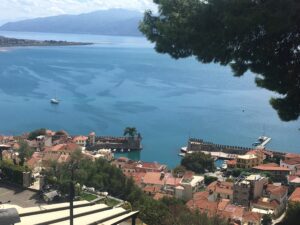 one battlemented wall from another. They are doing up the Ottoman hamman – bathhouse – I can see men working in the little domed roof dotted with oculi. The buildings of the enemy are now history, to be preserved not destroyed. Walk past lounging cats and bougainvillea hanging over walls. Don’t get to the very top, because stop for a coffee at a charming bistro, how nice they are. Scent of pine
one battlemented wall from another. They are doing up the Ottoman hamman – bathhouse – I can see men working in the little domed roof dotted with oculi. The buildings of the enemy are now history, to be preserved not destroyed. Walk past lounging cats and bougainvillea hanging over walls. Don’t get to the very top, because stop for a coffee at a charming bistro, how nice they are. Scent of pine 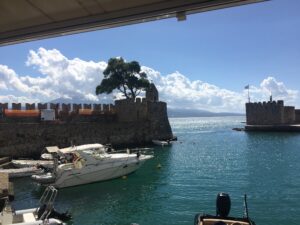 trees, views down to the circular Venetian harbour and out over the gulf is the great new bridge we cross tomorrow, and the mountains of the Peloponnese. Wasn’t it there Don John of Austria destroyed the Ottoman fleet at the battle of Lepanto, reversing the tide of Islam? Yes.
trees, views down to the circular Venetian harbour and out over the gulf is the great new bridge we cross tomorrow, and the mountains of the Peloponnese. Wasn’t it there Don John of Austria destroyed the Ottoman fleet at the battle of Lepanto, reversing the tide of Islam? Yes.
Walk back by the road because I feel unbalanced descending crumbly steps, and past a modern necropolis packed with marble gravestones 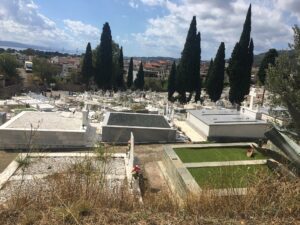 like a hostel crammed with white double beds. Past the beautiful harbour, and a decrepit mosque now opened occasionally for events, to our hotel – but there is a seaside bistro where I know Bob will be so join him for a beer and finish his salad.
like a hostel crammed with white double beds. Past the beautiful harbour, and a decrepit mosque now opened occasionally for events, to our hotel – but there is a seaside bistro where I know Bob will be so join him for a beer and finish his salad.
Next morning, the owner’s daughter says get in my car, and drives us out of town to the new bus station and says goodbye. Thank you dear lady. Bus station spacious, we have a coffee until our bus leaves. Then, off, again along the coast and we have a pang when we see sign 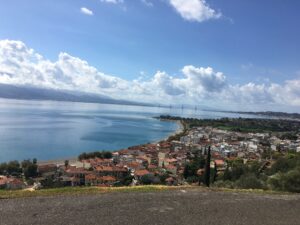 to Messolongi – where Byron died, we’d like to make a pilgrimage! But the bus swings left and (contrary to what we were told in Delphi, where they said we’d be on a ferry, the bridge was too expensive) swoops over the bridge and across the blue Gulf of Corinth to the Peloponnese.
to Messolongi – where Byron died, we’d like to make a pilgrimage! But the bus swings left and (contrary to what we were told in Delphi, where they said we’d be on a ferry, the bridge was too expensive) swoops over the bridge and across the blue Gulf of Corinth to the Peloponnese.
Copyright Sarah Coles 2018 Privacy Policy Website Design & Creation Forum Media and Design - Alresford